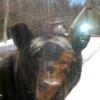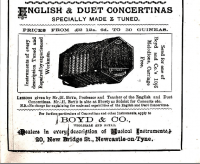-
Posts
255 -
Joined
-
Last visited
Everything posted by Laitch
-
Will Harmon is a writer, editor, fiddler, fiddle tutor, pie maker, mountain biker and who-knows-what-all out of Montana, USA who fiddles a lot in the Irish style. He's composed several interesting tunes along the way. Here's someone starting a set with that tune and almost riding it off the rails. 😊
-
This one does! It's in the third post above yours.
-
Go to Catskill where not only you'll get technique learning opportunities but also will be immersed in the dance and song to which the music is dedicated.
-
Here are some permutations of support. Consensus optional.
-
Go to YouTube and search for C/G concertina or G/D concertina.
-
It's in the metal. In fact, I believe that's my concertina shown in #20. I recall doing that with the red circle (quite an accomplishment given my complete lack of Photoshop skills) the last time Boyds were discussed. That photo is an extract from this recent for sale post, Jay, to which I added the red circle. Here is another Wheatstone with bowing valves.
-
A search of this site brings up these, among others. First, an advertising description of H. Boyd. Here is his name in an endplate.
-

My Apologies To Free Reed Players Everywhere.
Laitch replied to Frederick Wahl's topic in Concertina Videos & Music
-

Copy Right Issues And The Posting Of Unique Arrangements
Laitch replied to Noel Ways's topic in General Concertina Discussion
In the USA it would not be OK. Your Schutz/Ehret example doesn't apply because the music is approximately 300 years beyond US copyright protection. Cutting's work is under copyright protection until 95 years after his death. Read this page and the pages following it. The strict application is that you need his permission to do anything beyond playing it for your own or your friends' pleasure in a private setting. As Jim has indicated, getting his permission is the right thing to do. -

General Care / Maintenance Of Conertinas
Laitch replied to Chris_Hill's topic in General Concertina Discussion
Play tunes every day. Play all the notes on the instrument every day. Wipe the dust off the bellows and ends with a dry soft cloth. Store it where temperature is relatively stable. Avoid leaving it in hot vehicles or in snowbanks. -
My guess is that it worked by sounding one set of reeds when air was drawn through them during opening of the container and the other set when air was pushed through them during closing of the container. The sound of the chords could eventually act as an alarm to detect over-consumption of biscuits—a seemingly self-defeating marketing strategy for a biscuit maker.
-
Isn't that the renown Slide Engine and its designer playing in the first tune? Good show!
-

Audio Recordings Of Rolls On Anglo Concertina
Laitch replied to beryl's topic in Teaching and Learning
Consider discussing the situation with Junior Stevens, beryl. You can hear him play Clover, Jeffries, and Ball and Beavon C/G anglos at this Button Box webpage. Scroll down to find them and click on their videos. -

Micilín Conlon's Cottage For Sale
Laitch replied to Lawrence Reeves's topic in General Concertina Discussion
I think it's the greenhouse/kitchen that runs up the price. -
It is like an cortado/espresso but instead of adding milk you whip about 8 grams of sugar into the coffee.
-
Of course, on that break I had café cubano in a demi-tasse.
-
I'm using a Safari on a Mac and that's how it's done. It took me thirty seconds including a coffee break to reply to you just now, Atzarin.
-
Well, he's got the Dickens character down pat anyway. Good show. If you are able to post some photos, Ken, and inform us whether it has a Jeffries or Wheatstone keyboard layout, that might hasten the sale. I hope equilibrium is restored soon.
-

Clare Music 'field' Recordings New At Clare Library
Laitch replied to Peter Laban's topic in General Concertina Discussion
My thanks go to Peter, Anthony Edwards, Maureen Comber, all donators, all the singers and musicians, and the Clare Library for providing the music, images, sound files, biographies and descriptions to us all. Access to this work and act of generosity will be an enormous benefit to those of us interested in the music. -

Music For A Found Harmonium - For G/d Anglo
Laitch replied to Will Moore's topic in Concertina Videos & Music
This app is still available from several sources on the Web. -

Music For A Found Harmonium - For G/d Anglo
Laitch replied to Will Moore's topic in Concertina Videos & Music
One reason there are slightly differing copies of the same tune might be that variation is an essential part of Irish tune playing. A tune can vary from region to region, person to person, and even in each repetition of one person's playing of it. Each tune has a core structure—bones—that is identifiable; what holds those bones together varies from wire to lace. Many of those versions might be players just showing each other ways they've come up with to play the core tune; some of them might be established regional variations of a tune. Some of them might be mislabeled and misplaced rubbish by the people who post them. -

Music For A Found Harmonium - For G/d Anglo
Laitch replied to Will Moore's topic in Concertina Videos & Music
The sheet music to that tune is on that link, Will. Click the sheet music button. You can the compare the sheet music to the abc notation as a start to comprehension of their relationship—like with the samples John has provided. Each score variation on that site is developed from its corresponding abc file. Lean abc here. -
This site may help you. You pick out a song, scroll to the bottom of the lyrics and you can choose abc. You'll get the abc notation to compare with the sheet music. If you click midi, you'll discover if your computer is set up for playback of the abc file. If it plays, you'll be hearing how the abc file sounds.



